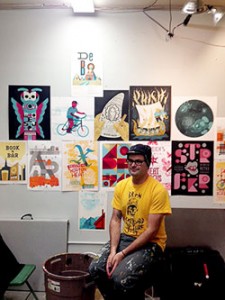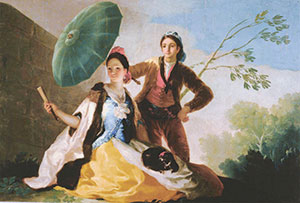
James Weinberg has fully embraced the challenge of deconstructing Goya.
By Mariya Manzhos
Somerville graphic artist James Weinberg spent nearly 20 hours examining The Parasol, a painting by the Spanish artist Francisco Goya. After a while, the details of the image started blurring together. “The dog’s paw started looking like the face,” laughs Weinberg. His task was to convert an elaborate masterpiece into a paint-by-numbers mural to be installed in Copley Square on October 18 and 19. With the help of a stepladder and an array of paints, the public will be invited to join collectively in coloring the mural over the weekend.
The idea of the mural was hatched as an extension of the Goya exhibition “Order and Disorder” that opened at the Museum of Fine Arts earlier this month. The team from the Spanish bank Santander, the official sponsor of the Goya exhibition, wanted to bring a part of the show outside the museum walls and engage more directly with the community. “A lot of times art is not a participative activity, and this will be,” said Michael Bruno, the region president for Northeast New England at Santander. Choosing a local artist to give Goya’s piece an interactive nature was the perfect way to bring awareness of the exhibit and celebrate the arts on a local level, according to Bruno.
When Weinberg accepted the commission for the mural, he had to come up with a process for adapting a classical image into a simplified paint-by-numbers drawing. “I didn’t have a reference point for how to make it happen,” says Weinberg, who works primarily in silkscreen printing and graphic arts. Last year, the artist designed a mural of the Somerville landscape at Assembly Row, but adapting a classical painting was completely new for him.
Weinberg began by breaking down the Parasol into over a 100 geometric shapes. He then matched the Parasol’s rich palette to the Pantone color matching system. Originally Weinberg thought he could reduce the palette to 12 colors, but ultimately had to expand it to 16. The process of breaking apart the colors was a useful exercise. Weinberg says through such a close study of the painting he paid attention to Goya’s choice of colors in the foreground and small details he otherwise wouldn’t have noticed.

The Parasol, 1777 by Francisco Goya y Lucientes. Oil on canvas. Museo Nacional del Prado. Madrid.
“I had to undermine Goya’s painting techniques and simplify it,” said Weinberg. He predicts that through this simplified interpretation the mural will look more graphic and poppy. He found that his experience with illustration and silk-screen printing prepared him for the re-coloring and re-scaling required.
The mural will be printed on material similar to a billboard and installed on a freestanding wall, since the city doesn’t allow painting directly on walls.
The future home of the finished mural has not been decided, but Santander’s Michael Bruno mentioned that the MFA is interested in hanging it in its galleries.
Weinberg works in a medium sized studio on Somerville Ave. It’s located in the basement of a space shared by artists and a catering company. His friend, who is a photographer, found the place eight years ago and invited Weinberg to join him. “I started printing just a few things in the corner,” Weinberg recalls. As a day job, Weinberg used to do book designs and covers for a publishing company, but two years ago with side-projects picking up, he transitioned to freelancing full-time. His work includes printing for the MIT Media Lab, Coolidge Corner theatre, local bands, and other designers and studios around Boston. “I have the set-up, so I can do my work, but I have to subsidize it,” says Weinberg. He also occasionally designs and prints holiday cards and wedding invitations. This semester he is teaching a class on typography for illustrators at the Massachusetts College of Art and Design.
When he is not doing client work, Weinberg likes making art prints. A few prints hanging on a wall in his studio feature Somerville vistas and rooftop views. The artist says he tries “to capture Somerville’s changing landscape, its scrap yards and weird areas.” Other prints reveal the artist’s fascination with natural history illustration, particularly otherworldly sea creatures. He has also been experimenting with typography as art, using geometric shapes to make typographic forms.
Weinberg draws inspiration from mid-20th century designers like Saul Bass and Charley Harper, who explored geometric mosaics and stylized wildlife prints, respectively. “I have a weird connection to the 60’s,” says Weinberg pulling out a bright poster he did for Debo, a band from Jamaica Plain. This interest in psychedelic art led him to experiment with combining bright color schemes that evoke intense optical color vibrations.
Weinberg is currently gearing up for ARTCRANK, a bike poster show opening next weekend at the Aeronaut Brewery. Weinberg admits that even though there is large community of talented artists of all mediums in Somerville, it’s hard to find a place to host a show. “There should be more venues in Somerville,” says Weinberg.












Reader Comments